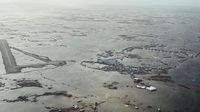In the days following a devastating storm that struck southwestern Alaska, communities along the Bering Sea have been left reeling, with widespread destruction, loss of life, and a historic evacuation effort unfolding. The remnants of Typhoon Halong, which battered the region over the weekend before October 16, 2025, unleashed record storm surges, hurricane-force winds, and a humanitarian crisis that has drawn national attention to both the resilience and vulnerability of Alaska’s remote Native villages.
The villages of Kipnuk and Kwigillingok, home to roughly 1,000 people combined—almost all Alaska Native or American Indian, according to Census Bureau data—were among the hardest hit. The storm surge pushed water levels more than six feet (1.8 meters) above the highest normal tide line, as reported by the National Weather Service and confirmed by multiple outlets including the Associated Press and Alaska Public Media. The impact was catastrophic: homes were swept off their foundations, some floating out to sea, and at least one person, 67-year-old Ella Mae Kashatok, lost her life. Two others, Chester Kashatok, 41, and Vernon Pavil, 71, went missing after their home was carried away by floodwaters; the search for them was called off on October 13 after what authorities described as a “robust and extensive” effort.
As the scale of the disaster became clear, officials launched one of the most significant airlifts in Alaska’s history. Hundreds of residents from these isolated communities—reachable only by air or water at this time of year—were evacuated by helicopter and military transport plane. Over 300 evacuees were flown approximately 500 miles to Anchorage on Wednesday, October 15, with the Alaska Airlines Center, a sports and events complex, repurposed to shelter up to 400 people. According to the Alaska Department of Military and Veterans Affairs, the operation was unprecedented in its scope and urgency.
Meanwhile, the regional hub city of Bethel, which had quickly established a shelter at a National Guard armory, was overwhelmed. By mid-October, the facility was filled with dozens of evacuees, and the food supply was “near depletion,” as FEMA officials noted in a Thursday briefing. In total, around 1,600 people were being housed in about 13 shelters across the Yukon-Kuskokwim Delta, with authorities racing to move evacuees from crowded, makeshift accommodations into hotel rooms or dormitories as winter loomed. The Red Cross estimated that about 2,000 residents had been directly impacted by the storm surge and high winds, and hundreds of disaster workers from across the country were mobilized to assist.
Conditions in the shelters were challenging, to say the least. In Kwigillingok, where about 350 people took refuge at the local school, toilets were not working, though restroom facilities and cell phone service were restored by midweek, according to state emergency management statements. In Kipnuk, power and telecommunications were unreliable, adding to the hardships faced by displaced residents. “It’s catastrophic in Kipnuk. Let’s not paint any other picture,” Mark Roberts, an incident commander with the state emergency management division, said during a press conference. “We are doing everything we can to continue to support that community, but it is as bad as you can think.”
Damage assessments have been slow and sobering. In Kipnuk alone, officials reported that 121 homes—out of a population of about 700—were destroyed. Many structures are beyond repair, with emergency management officials warning that some homes cannot be reoccupied even with emergency fixes, and others may not be livable by winter. The storm also knocked out water, sewer, and well systems in other affected villages, and the Coast Guard was dispatched to assess a spill of up to 2,000 gallons of waste oil in a nearby community. The logistical challenges of bringing in construction materials and restoring basic services are compounded by the region’s remoteness and the fast-approaching winter, with forecasters predicting rain and snow and temperatures soon dropping below freezing.
The crisis has also reignited debate over federal disaster preparedness and support for Indigenous communities. As reported by The Guardian and the Associated Press, the Trump administration previously terminated a $20 million Environmental Protection Agency grant that was intended to help Kipnuk protect its infrastructure from erosion and flooding. The grant would have funded improvements to the boardwalk—a vital artery for residents—and protective measures for over 1,400 feet of riverbank, but the project was halted with only minimal progress made. Environmental groups and local leaders have criticized the loss of federal support, arguing that it left the community more vulnerable to exactly the kind of disaster that has now unfolded. “What’s happening in Kipnuk shows the real cost of pulling back support that was already promised to front line communities,” said Jill Habig, CEO of the Public Rights Project, who added, “When that commitment is broken, it puts people’s safety, homes and futures at risk.”
Local officials have been urging residents to heed evacuation orders and not risk staying behind. Buggy Carl, Kipnuk’s tribal administrator, told Alaska Public Media, “Right now, just trying to convince everybody to go before the next storm hits.” However, not all residents are willing to leave, with some opting to stay with friends or family, or simply reluctant to abandon their homes despite the dangers. Jeremy Zidek, spokesperson for the state emergency management office, acknowledged the uncertainty, saying that authorities could not always determine where evacuees were coming from or how many might choose to remain in the affected villages.
As the immediate focus remains on ensuring the safety and well-being of those displaced—making sure people are “safe, warm and cared for,” as Mark Roberts put it—the longer-term recovery is expected to be arduous. Most construction materials must be flown or shipped in, and with winter’s arrival imminent, time is running short for repairs or rebuilding. State and federal agencies, along with non-profit organizations, are coordinating efforts to restore essential services and secure more permanent housing for evacuees, but the road ahead is daunting.
For now, the story of Kipnuk and Kwigillingok stands as a stark reminder of the vulnerability of remote communities in the face of extreme weather, the vital importance of disaster preparedness, and the profound impact of policy decisions made far from the windswept coasts of Alaska. As residents face an uncertain future, their resilience and the support of a mobilized nation will be tested in the challenging months to come.





